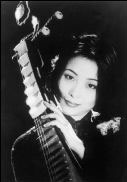SEATTLE SYMPHONY’S FUSION FESTIVAL
Benaroya Hall, Third and Union, 215-4747, $15-$49 performance and lecture times vary; ends Sat., May 19
ASIAN MUSIC, whether by Asian composers or by Americans eager to explore new sounds, has captured the attention of classical listeners and musicians more than any other style in recent memory (at least since the “holy minimalist” works of religiously oriented composers like Arvo P䲴 and John Tavener first came to prominence 10 or 15 years ago). And, though our geographic proximity makes us more likely to look to Asia than to Europe, this isn’t just a local musical phenomenon; it’s nationwide. Tan Dun’s Oscar for his score to Crouching Tiger, Hidden Dragon is the most mainstream manifestation of this interest, and composers like Bright Sheng, P.Q. Phan, Chinary Ung, and Chen Yi are among the busiest in the business. Even the Bellevue Philharmonic, not usually known for cutting-edge programming, is getting in on the act; their 2001-2002 season will include a striking amount of contemporary Asian music, thanks to the enthusiasm of conductor Fusao Kajima.
Dun’s Concerto for String Orchestra and Pi-pa, with soloist Wu Man on the bright-toned Chinese lute, will be performed on May 17 as the Seattle Symphony recognizes the current trend with the bountiful offerings (concerts, lectures, symposia) of their current Fusion Festival. Music director Gerard Schwarz invited Sheng, a former Seattle Symphony composer-in-residence, to co-organize the festival. Maximum variety—of approach, ethnicity, geography—was the goal, Sheng says, and the concert lineup includes pieces by composers from Central Asia, Eastern Russia, and Australia, as well as the Far East.
There may even be sociological reasons behind the current Asian infatuation. It might not be too far-fetched to suggest that the political upheavals many Asian composers have endured in past decades have resulted in music with a greater emotional depth, which listeners somehow sense and respond to. No American or Western European composers since World War II have lived through anything like the Cultural Revolution or the Vietnam War (a theory that might also account for the popularity of several Soviet composers, Shostakovich in particular). One work in the festival that draws on Asian history is Sheng’s Nanking! Nanking! (to be performed Thursday, May 17). A response to the 1936-1937 Japanese occupation of this Chinese city, the tone poem involves a pi-pa soloist (again Wu Man) that represents the individual against the larger social forces of the percussion-heavy orchestra. In this piece, written for the North German Radio Symphony in Hamburg, Sheng pays tribute to John Rabe, the “Schindler of Nanking,” a German resident of China who helped refugees escape the Japanese atrocities.
THERE’S ALSO the sheer timbral novelty of Asian instruments. Western composers have been intrigued, not just by these new sounds, but also by Asian ways of controlling and subtly altering sounds that make the Western attitude toward timbre seem a bit crude. This is what first sparked the interest of Bay Area cellist Hugh Livingston. Studying solo cello pieces by Ung and Toshiro Mayuzumi led Livingston to reconsider the whole question of string-instrument color. Copying the playing techniques of Asian string instruments resulted in fresh new cello sounds, and attempts to reproduce the sounds led him to new playing techniques. Livingston’s also been devising notational methods for all these sounds and is exploring correspondences between Chinese written characters and cello sounds as a basis for improvisation. On Thursday, May 17 at the Seattle Art Museum, he’ll present an improv performance drawing on musical materials and structures from Szechuan opera. Livingston will also lecture on his expanded sound vocabulary as part of the Fusion Festival (Saturday, May 19).
Seattle composer Christopher Shainin came to music as an adult; growing up untrained in the Western canon, his early musical interests included free jazz, which led to explorations of non-Western improvisation. Much of his work draws on music from all over, and he’s been involved with the Seattle Creative Orchestra and the Contemporary Chamber Composers and Players (CCCP). On Friday, May 18, the CCCP will present a lunchtime recital of four pieces, including his Story That Opens Like a Fan, a vocal/instrumental work that includes the yang-qin, or Chinese hammered dulcimer, plus music by Sarah Bassingthwaighte, Ryan Hare, and Brad Sherman.
WHY ASIAN MUSIC? Why now? First of all, exoticism in general has always been a potent ingredient in composers’ most ear-pleasing recipes, dating back to Haydn’s Gypsy tunes and the Iberianisms of Carmen. Many Asian composers, even if they’ve studied Western classical music, have been inspired by their homelands’ native traditions, and listeners respond to these folk elements—especially since so much Western concert music from the past century has avoided the vernacular. And both folk styles and the cultivated “art music” traditions of Asia have a long, venerable, comparatively unchanged history, which adds weight to the music of contemporary composers who draw from these streams. No doubt the modal scales and drones sometimes used in Asian music provide harmonic comfort for listeners who never quite developed a taste for European modernism—yet microtonal effects and pitch-bending also add savor to the Asian harmonic language.







